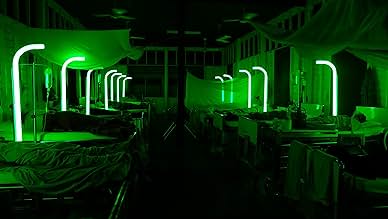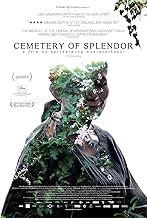NOTE IMDb
6,8/10
5,8 k
MA NOTE
Un groupe de soldats dans un petit village sur le Mékong au nord de la Thaïlande est frappé par une mystérieuse maladie du sommeil.Un groupe de soldats dans un petit village sur le Mékong au nord de la Thaïlande est frappé par une mystérieuse maladie du sommeil.Un groupe de soldats dans un petit village sur le Mékong au nord de la Thaïlande est frappé par une mystérieuse maladie du sommeil.
- Réalisation
- Scénario
- Casting principal
- Récompenses
- 7 victoires et 17 nominations au total
Jenjira Pongpas
- Jenjira
- (as Jenjira Pongpas Widner)
Avis à la une
In Thailand, an elementary school has been turned into a clinic to care for soldiers suffering from a mysterious sudden sleeping sickness. Jenjira is a housewife volunteer at the clinic. She takes more interest in one particular patient Itt. Whenever he wakes, she befriends him. Others claim the school was built on an ancient Royal cemetery and the soldier's energy are being drained to fight battles in the other world. Jenjira befriends medium Keng who claims to be able to be possessed by the comatose men.
The camera style is very static. The camera is set up in one position and the scene unfolds without any edits. These scenes last as long as a minute or two. It has a hypnotic feel at first but it does get boring after awhile. The central mystery keeps one's interest but it gets more and more perplexing. It becomes an exercise in surreal storytelling. There are some head-scratching things going on and sometimes I wonder if they are dreams. Also why are they digging up the field? It would be more compelling if the visuals could be more surreal. They need to be more imaginative and crazier. The movie needs to explain better or be completely inexplicable.
The camera style is very static. The camera is set up in one position and the scene unfolds without any edits. These scenes last as long as a minute or two. It has a hypnotic feel at first but it does get boring after awhile. The central mystery keeps one's interest but it gets more and more perplexing. It becomes an exercise in surreal storytelling. There are some head-scratching things going on and sometimes I wonder if they are dreams. Also why are they digging up the field? It would be more compelling if the visuals could be more surreal. They need to be more imaginative and crazier. The movie needs to explain better or be completely inexplicable.
Every moment of this film is enjoyable. For much of the movie, it struck me as no more or less than a solid example of the cinema of auteur Arichitapong Weerasthakul. He is, perhaps, the most sincerely and successfully magical-realist artist that cinema has known. The social rhythms seem utterly naturalistic, even when the main character, an old, recently handicapped hospital worker, is having a pleasant chat with ancient deities. As with early Peter Weir, Weerasthakul's natural landscapes are utterly, well, natural yet they seem to suggest a haunting, an otherworldly force that's face is the world, one which may or may not be benevolent. History, for Weerasthakul, is the haunting of the present and future by past lives and past worlds, spectral- beings that traverse and are traversed by the present.
During Cemetery's last scenes I came to think this may be Weerasthakul's most fully realized work. The penultimate shot is extraordinary. The main character stares out at a central square of the village where the film has taken place, which the current government is digging up, presumably to make way for some "modern convenience". Children play over the new ruins like spirits of the future levitating over a present fading into the past. Our lives, our worlds, can only exist atop the ruins and amid the ghosts of the past. Destruction is therefore creation. But that doesn't make destruction, perhaps especially in its contemporary, mechanized form, any less terrifying.
During Cemetery's last scenes I came to think this may be Weerasthakul's most fully realized work. The penultimate shot is extraordinary. The main character stares out at a central square of the village where the film has taken place, which the current government is digging up, presumably to make way for some "modern convenience". Children play over the new ruins like spirits of the future levitating over a present fading into the past. Our lives, our worlds, can only exist atop the ruins and amid the ghosts of the past. Destruction is therefore creation. But that doesn't make destruction, perhaps especially in its contemporary, mechanized form, any less terrifying.
Once again Weerasethakul comes to us with an enigmatic, folklore-linked story. I find his stories and style of cinema to what Romania does with its cinema. The subject is so foreign and exotic to the normal cinephile, which 80% of the time, because of sheer quantity, consumes American cinema, that when we get to live such a film we are either fooled or dazzled by the narrative.
This is what I feel about Romanian cinema. I, being romanian, see romanian films about communism as something akin to beating a dead horse - and pretty bland cinematically. As a filmmaker that is a very interesting topic to tackle because of the lack of criticism, we couldn't satisfy back then...so, of course, we're gonna milk that cow for as long as possible, mostly because that romanian new wave was filled with directors that lived in that dying period of romanian communism.
The same is happening with Weerasethakuls movies. They are exotic, different, and out-of-the-ordinary...so because of this fresh air approach, the cinephile will most of the time love it unconditionally. I still think his images communicate something more than what is told but we should be skeptical while watching this...he might just dazzle us.
I feel the sleeping soldiers are a metaphor for the laziness of man and his lack of action. And we can find the main actress here also in "Syndromes...", so it's the same universe, as well as the ever-present erection.
This is what I feel about Romanian cinema. I, being romanian, see romanian films about communism as something akin to beating a dead horse - and pretty bland cinematically. As a filmmaker that is a very interesting topic to tackle because of the lack of criticism, we couldn't satisfy back then...so, of course, we're gonna milk that cow for as long as possible, mostly because that romanian new wave was filled with directors that lived in that dying period of romanian communism.
The same is happening with Weerasethakuls movies. They are exotic, different, and out-of-the-ordinary...so because of this fresh air approach, the cinephile will most of the time love it unconditionally. I still think his images communicate something more than what is told but we should be skeptical while watching this...he might just dazzle us.
I feel the sleeping soldiers are a metaphor for the laziness of man and his lack of action. And we can find the main actress here also in "Syndromes...", so it's the same universe, as well as the ever-present erection.
Apichatpong Weerasethakul had been on my radar after the elusive critical praise for his earlier work that seem fit only for lists like They Shoot Pictures. He doesn't seem to satisfy general audiences in the same way, despite winning at Cannes for Uncle Boonmee. Ostensibly his most personal film, Cemetery of Splendour seemed like a good start. It was certainly an introduction to his ambiguity which Splendour indulges in at every opportunity. It's very rich with its themes, though you have to go with the flow on its spirituality, belief in past lives and superstition, but those themes don't necessarily feel like they string together. More knowledge on Thai politics, history and culture would certainly help to arrive at a concise interpretation, but it does have enough universalities.
There is, however, a fascinating way it contrasts past and present simultaneously. That's its best ambiguous angle. Each shot can be its own individual thought rather than giving myself headaches trying to piece it together. Weerasethakul at least has a wonderful sense of poetic composition and juxtaposition, his choice of a rainbow light aiding him in many senses. But besides the calm and often profound nature of the film, what makes it strike a nerve is the deeply resonating performance from his lead Jenjira Pongpas. She balances humour with empathetic emotion with nuanced ease and anchors the film in her relateability despite her unique situation with her tumurous leg. Cemetery certainly gives a lot to chew on.
8/10
There is, however, a fascinating way it contrasts past and present simultaneously. That's its best ambiguous angle. Each shot can be its own individual thought rather than giving myself headaches trying to piece it together. Weerasethakul at least has a wonderful sense of poetic composition and juxtaposition, his choice of a rainbow light aiding him in many senses. But besides the calm and often profound nature of the film, what makes it strike a nerve is the deeply resonating performance from his lead Jenjira Pongpas. She balances humour with empathetic emotion with nuanced ease and anchors the film in her relateability despite her unique situation with her tumurous leg. Cemetery certainly gives a lot to chew on.
8/10
Without having known before, 20 minutes into the film I guessed that it was from the same director of Uncle Boonmee Who Can Recall His Past Lives. Weirdly, I didn't take to that film much. I appreciated it greatly, and I did get more out of it on my second viewing of it, but it still left me feeling very distant. I found this much more fixating and engrossing, even if the pace does get to me at times. It's amazingly directed and I think that carries it a long way, but it also benefited from being more grounded on a simple thematic level than Boonmee. Not for everyone, but definitely a film to watch out for. Not recommended for everyone, just for those who know exactly what they're getting into.
Le saviez-vous
- GaffesWhen Itt and Jenjira are eating dinner in the city, several bystanders are seen looking and pointing at the crew.
- ConnexionsFeatured in The Story of Film: A New Generation (2021)
Meilleurs choix
Connectez-vous pour évaluer et suivre la liste de favoris afin de recevoir des recommandations personnalisées
- How long is Cemetery of Splendor?Alimenté par Alexa
Détails
- Date de sortie
- Pays d’origine
- Site officiel
- Langues
- Aussi connu sous le nom de
- Cemetery of Splendor
- Lieux de tournage
- Sociétés de production
- Voir plus de crédits d'entreprise sur IMDbPro
Box-office
- Montant brut aux États-Unis et au Canada
- 51 950 $US
- Week-end de sortie aux États-Unis et au Canada
- 7 780 $US
- 6 mars 2016
- Montant brut mondial
- 98 932 $US
- Durée2 heures 2 minutes
- Couleur
- Mixage
- Rapport de forme
- 1.85 : 1
Contribuer à cette page
Suggérer une modification ou ajouter du contenu manquant

Lacune principale
By what name was Cemetery of Splendour (2015) officially released in India in English?
Répondre























